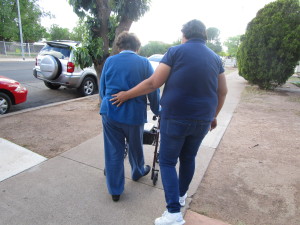
Rosa Buelna supports her 75-year-old mother’s back as she walks around, pushing her walker in front of her. She does this for her mother every single day, and so much more.
Ysidra Buelna had three strokes in the past, and her daughter Rosa Buelna, 47, tends to her needs from day to night.
She has been her mother’s stay-at-home caregiver for 15 years. She starts her day at around 7 a.m., and prepares food for herself and her mother so they can eat breakfast come 8:30. Throughout the day, she helps her mother take a shower or use the bathroom, walk around the house, get up from her bed or her recliner in the living room, prepares her food and even takes her on walks to the park or just around the neighborhood. On top of that, she maintains and cleans their home, and tends to their two dogs and one bird.
“I stay [at] home 24 hours,” Rosa Buelna said. “I’m used to it now.”
More Americans are deciding to turn to caregiving.
Almost 44 million U.S. adults, or 18.2 percent of the U.S. population, provide care for a family member or a spouse, according to a 2015 report conducted jointly by the National Alliance for Caregiving and the AARP Public Policy Institute.
One of the reasons people turn to caregiving is because of the lower costs of providing home care compared to nursing homes. The average annual cost for a private room in a nursing home is $87,235, while the average annual cost for home care can range from $19,760 to $21,840, according to a 2011 survey conducted by MetLife.
Buelna said she decided to provide care to her mother herself because she feels like the health of her mother is her responsibility.
“Right now, it’s more easy [for] me to take care [of] my mom than other people,” Buelna said. “Sometimes, it’s not the same with others.”
On average, caregivers provide about 62 hours of help per week, according to the report.
“Caregiving is a 24-hour job,” said Yolanda Thomas, case manager for the Douglas, Arizona, division of the Area Agency on Aging, which provides services, including home care, to the elderly and people with disabilities.

Caregivers help with activities of daily living like bathing, getting dressed or eating, instrumental activities of daily living like preparing meals, cleaning the house or managing finances, and medical or nursing tasks, which can range from helping with their medication to giving injections.
“They oversee the complete care of a person,” Thomas said.
Researchers have been looking at the so-called caregiver burden, a term used to describe the physical, emotional and financial stress of caregiving, according to the American Academy of Family Physicians.
Buelna admits that although she would like to think that she is used to caregiving, it gets stressful for her sometimes.
“… I feel stressed because my mom needs help and … sometimes … I feel very sick,” Buelna said. “Sometimes, [I] need help, for other people to come.”
According to the 2015 report, two in five caregivers reported their caregiving situation as emotionally stressful, one in five reported a high level of physical strain and another one in five reported experiencing financial strain.
Researchers have suggested that “the combination of loss, prolonged distress, the physical demands of caregiving, and biological vulnerabilities” of caregivers may result in a higher risk of attaining health problems, according to a study published on the Journal of the American Medical Association.
Other researchers, however, argue that caregiving isn’t as bad as the media makes it out to be and that these reports “commonly present an overly dire picture of the health risks associated with caregiving and largely ignore alternative positive findings,” according to a study published on the Gerontologist.
“The message is clearly out that informal caregiving is, in general, a stressful obligation that is hazardous to the caregivers’ health,” the researchers stated in the study. “However, a more balanced view of the entire body of population-based studies, especially those examining actual mortality, appear to suggest a different overall conclusion.”
Regardless, Thomas said she believes that people should not underestimate caregiving and give caregivers more credit than they are receiving.
“I think we don’t realize that their day is, I will say, worse than taking care of a kid,” Thomas said. “It is a full-time job and it is stressful and very demanding.”
In Buelna’s opinion, despite the stress and the high demand of caregiving, it’s worth it because she gets to spend more time with her mother.
“My favorite thing [is] when my mom and me, eating, listen [to] music and watch TV,” Buelna said. “Every day is different.”
Joanna Daya is a reporter for Arizona Sonora News, a service from the School of Journalism with the University of Arizona. Contact her at [email protected].
Click here for high resolution photos.

